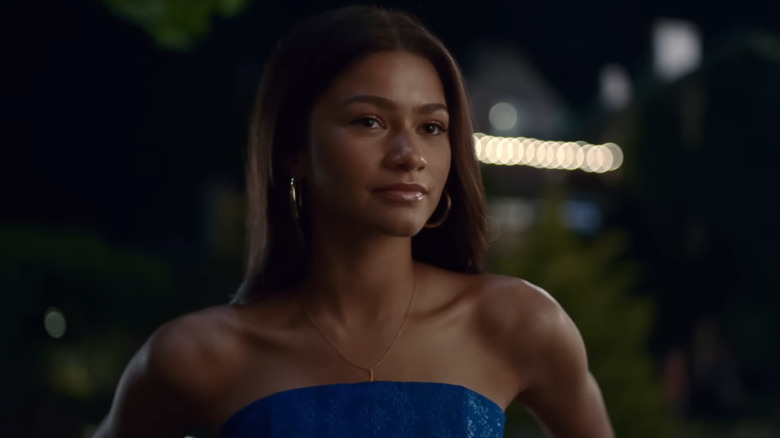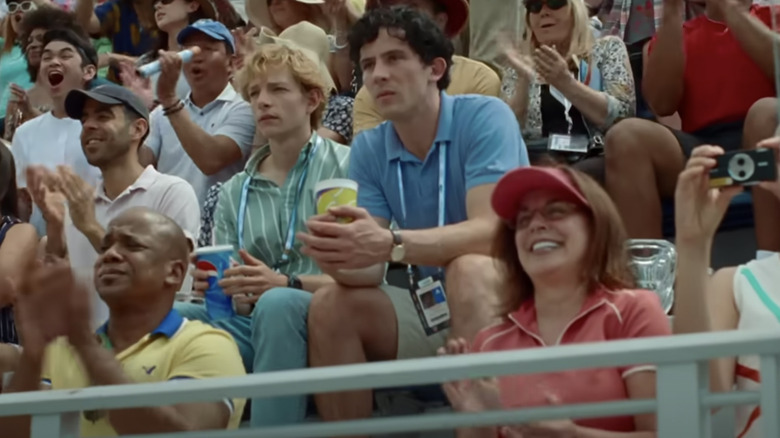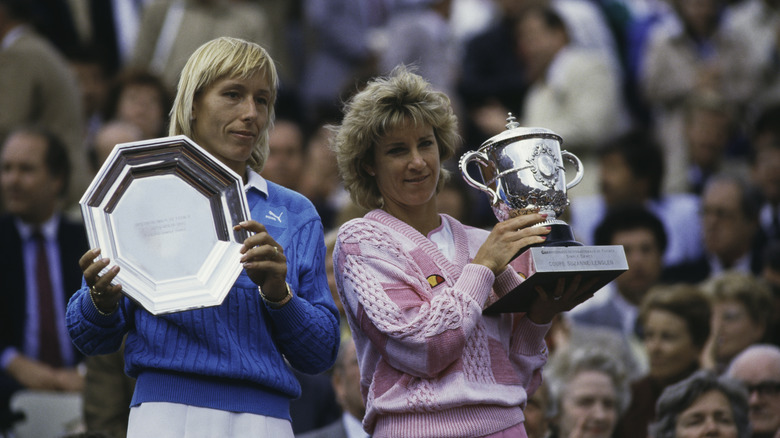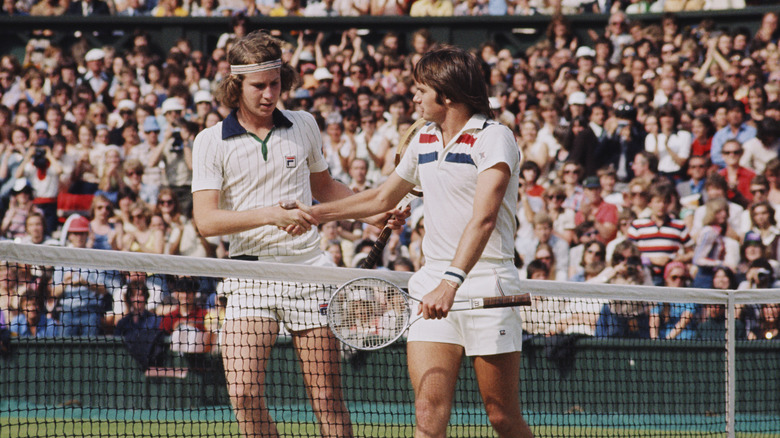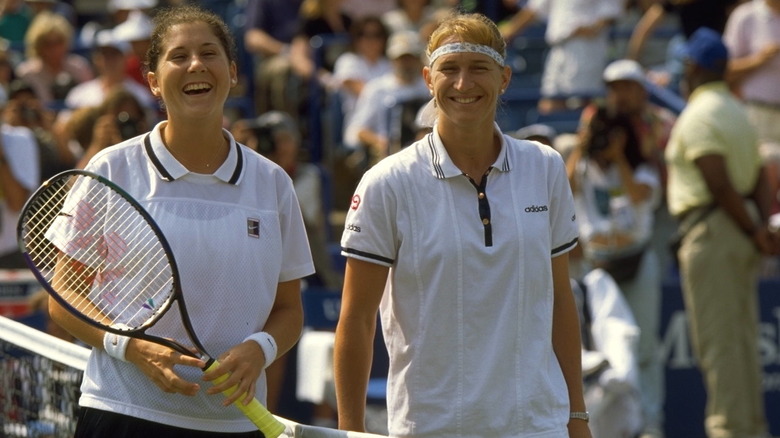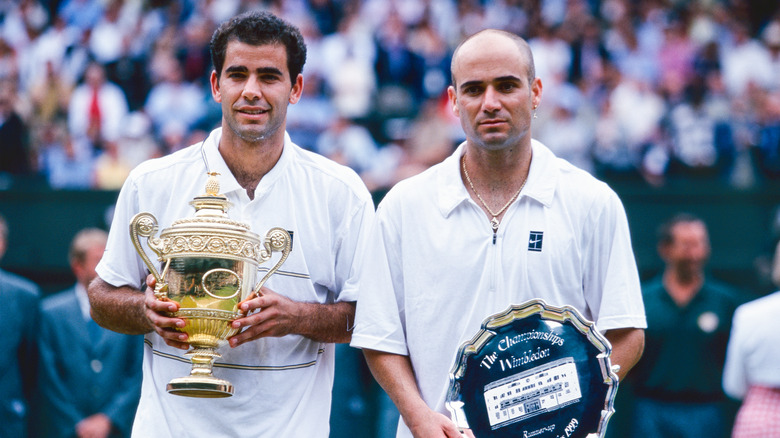Challengers: No, It's Not A True Story - But These Tennis Rivalries Could Be Films
Summer blockbuster movie season is now underway, with Wes Anderson's "Asteroid City" and "Indiana Jones and the Dial of Destiny" premiering in the last week of June. MGM is also now promoting a fall release, the tennis-themed drama "Challengers," which stars Zendaya as teen hardcourt phenom Tashi Duncan. "Challengers" is directed by Luca Guadagnino ("Call Me by Your Name," "Bones and All") and is scheduled for a September 15 theater release. The trailer shows Tashi and two other young tennis stars, Patrick (Josh O'Connor) and Art (Mike Faist), in a steamy hotel scene where they appear to form a love triangle.
The trailer then jumps ahead many years to show Tashi married to Art and serving as his coach after a serious knee injury ends her own career. While a sports-based film might seem to be a divergence from Guadagnino's previous ventures, he told Indiewire that Tashi, Patrick, and Art had a specific type of manic energy that connected them to the characters in his previous works.
"I think those three characters in that movie are beautifully complex and really f—ed-up people that I love very much," he said. "And a sports film, why not? It's hyperkinetic, and I do films, so it's great."
Josh and Art's rivalry exists on and off the tennis court
The trailer for "Challengers" shows Art and Josh competing as teenagers for Tashi's romantic attention and as junior tennis players. While it's not made evident who is the better player, it appears that early on, Patrick establishes a stronger connection with Tashi, referring to her as his girlfriend in one exchange with Art. However, it's Art who is shown at Tashi's side when she is injured, and the bond they form leads her to coach him to the pinnacle of the sport.
When Art hits a rough patch, though, he ends up facing his old friend in a lower-tier Challenger tour match. Patrick is apparently using the opportunity as a stepping stone back to the top ranks of the sport, and perhaps Tashi's life as well. "I think maybe you're disturbed by the fact that she could've been into someone like me," Patrick tells Art as the two now-adult players sit in a sauna together and reflect on their past.
While the rivalry between Patrick and Art is entirely fictional, the world of tennis has given us plenty of real rivalries that would make for compelling sports movies, beginning with a pair that faced off dozens of times throughout the 1970s and 1980s.
Women's tennis in the 1970s and 80s was the Martina and Chris show
Between 1973 and 1988, Martina Navratilova and Chris Evert played each other 80 times, including 60 times in tournament finals. They had completely contrasting playing styles and personalities, with the stoic Czech native Navratilova playing a serve-and-volley game best suited to the grass courts at Wimbledon and the bubbly power-hitting Evert sticking to the baseline and enjoying her greatest success on the hard surface at the U.S. Open and the clay courts at Roland Garros.
Their upbringing was also vastly different, with Navratilova defecting from Czechoslovakia as a teenager in 1975 and Evert enjoying a comfortable Florida childhood.
In 1986, Frank Deford of Sports Illustrated wrote an in-depth article on their rivalry, noting that the pair had developed a close friendship throughout their years in fierce competition with each other. "I know, whatever, I'll always stay in touch with Chris," Navratilova told Deford. "It'll be easier for us when the tennis is over. It's always good with us, though, and because she's such a good person, I feel that much better when I do beat her."
The John McEnroe-Jimmy Connors rivalry was not always friendly
While Martina Navratilova and Chris Evert were dominating the women's tennis tour, there was a rivalry at the top of the men's circuit that was not nearly as friendly or respectful. John McEnroe and Jimmy Connors, both of whom had fiery temperaments and short fuses, faced off 34 times, with McEnroe winning 20 of those matches. They met twice in the Wimbledon finals, each winning once. In a 2018 interview with Graham Bensinger, McEnroe first explained that the reason he and Connors didn't get along was simply because Connors was "a complete a–hole," then explained that perhaps the two hyper-competitive southpaws were just too similar to mesh well with each other.
"Obviously," McEnroe told Bensinger, "we sort of have some sort of Irish ancestry that, we might be somewhat volatile, get a little upset maybe more easily than others."
Connors echoed those thoughts to the French publication We Love Tennis, saying "I'm Irish, he's Irish, I am left-handed, he is left-handed, I have a bad attitude, he has a bad attitude. I always said I wanted to play against myself, and Mac came close to representing that fantasy," [via FirstSportz.com].
The Monica Seles-Steffi Graf rivalry was fierce
While many of the aforementioned rivalries featured many memorable on-court matches, one late '80s and early '90s feud actually led to on-court violence, although it wasn't between the two players. Steffi Graf held the No. 1 ranking in the WTA from August 1987 until March 1991. But in 1990, a young Yugoslavian named Monica Seles defeated Graf in the French Open Final, knocking her from the top spot in the rankings and kicking off a rivalry that would thrill fans for the next three years. Between 1991 and 1993, Seles and Graf would split all 12 Grand Slam titles, with Seles winning 7 and Graf taking 5.
Tragedy struck during an April 1993 match against Magdalena Maleeva in Hamburg, Germany, when an obsessed Graf fan named Günter Parche jumped onto the court during a changeover and stabbed Seles in the back. Parche received only a suspended sentence for the assault and Seles missed ten Grand Slam tournaments while in rehabilitation for her physical injuries and the psychological trauma suffered from the attack.
Graf won six of those tournaments, reclaiming her No. 1 ranking a little more than a month after Seles was stabbed. Less than two and a half years after the stabbing, Seles was back on the court, winning the 1995 Canadian Open. She lost to Graf in the U.S. Open final that year and the next, but added the 1996 Australian Open title to her trophy case. However, the stabbing cut her peak years short and prematurely ended a rivalry that could have ultimately matched that of Martina Navratilova and Chris Evert.
Pete Sampras and Andre Agassi fought for the No.1 ranking in the '90s
While Monica Seles and Steffi Graf were trading Grand Slam wins on the women's tour, a pair of American men with very different personalities and playing styles were fighting for the top spot on the men's circuit. Pete Sampras brought a businesslike demeanor and laser-precise 130-mile-per-hour serve to the court, while Andre Agassi's aggressive game and flashy personality made him a media darling. Agassi sported denim shorts and pink spandex on the court and sometimes wore his hair in a blond mullet, even voicing the slogan "Image is everything" in an ad for Canon Rebel cameras in 1989 (per Tennis.com). Agassi and Sampras faced off head-to-head 34 times in 13 years, with Sampras winning 20 of those matches and enjoying a 10-5 advantage over Agassi in major tournament competition.
The athletes spent many hours across the net from each other, competing from their time on the junior circuit through the end of their long professional careers. However, they never became close friends like Martina Navratilova and Chris Evert, nor did they develop the animosity that brewed between Jimmy Connors and John McEnroe.
In a conference call to promote a 2011 exhibition event in New York, Agassi explained the reason for the lingering distance between himself and Sampras. "I realized I never really knew him," Agassi said. "Two different guys, with different styles, who see the world differently. That was a bridge that was difficult to cross" (via ESPN).
